Apr 13, 2025
Apr 13, 2025
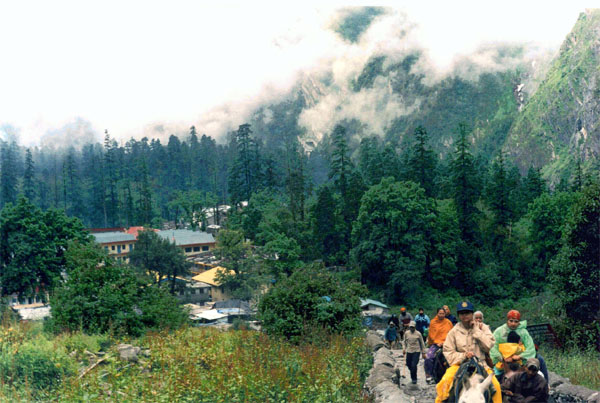 Our trek to Valley of Flowers and Hemkund Sahib starts from Govindaghat. Our first halt is at Ghangharia. After visiting Valley of Flowers, we halt again at Ghangharia. Next day we start our trek to Hemkund Saheeb, which is only 6 KM from Ghangharia. Hundreds of pilgrims move along chanting religious slogans. Horse, Pitthu, and Doli are there for who cannot trek. This picture is the view of Ghangharia as we are just leaving it behind for Hemkund.
Our trek to Valley of Flowers and Hemkund Sahib starts from Govindaghat. Our first halt is at Ghangharia. After visiting Valley of Flowers, we halt again at Ghangharia. Next day we start our trek to Hemkund Saheeb, which is only 6 KM from Ghangharia. Hundreds of pilgrims move along chanting religious slogans. Horse, Pitthu, and Doli are there for who cannot trek. This picture is the view of Ghangharia as we are just leaving it behind for Hemkund.
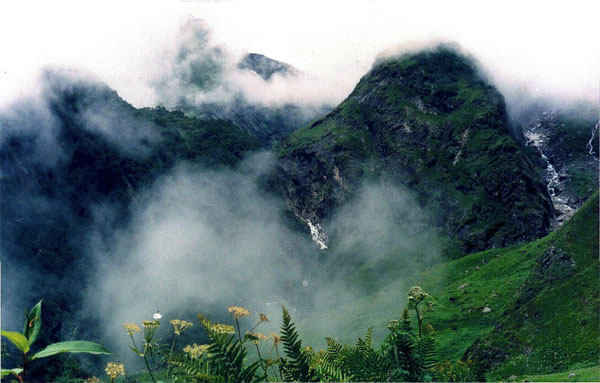
Gigantic Mountains stand on our way like giant eagles spreading wings, or Garuda himself welcoming our entry in the land of spiritual glory. It is often cloudy. We have plastic sheets to protect us from rain.
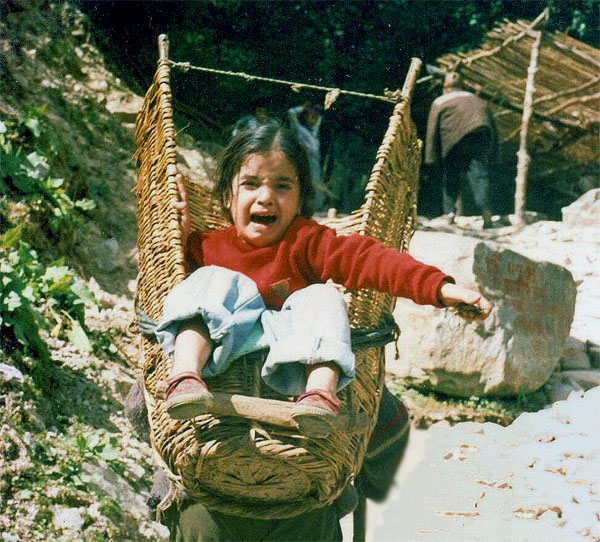
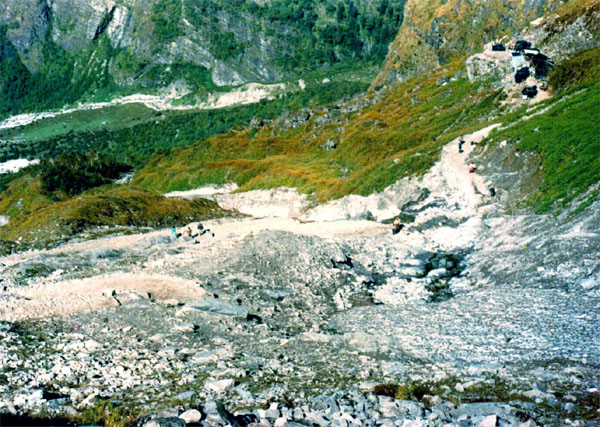
It is a steep ascent. The journey is quite grueling. The trek passes through forests of pine and rhododendron where wild roses, ferns, and alpine flowers bloom. Many pilgrims ride horse or ‘Pitthu’ or ‘Doli’. This young lady is certainly not enjoying her ride. Her parents are trailing.
We have just crossed this glacier. The winding trekking route can be seen down there. There are occasional ‘Chottis’ for snacks. Sometimes there are ‘mobile Langarkhanas’ of rich pilgrims profusely offering ‘pulao’, ‘sweets’ and glucose. All weariness is gone in a whiff.
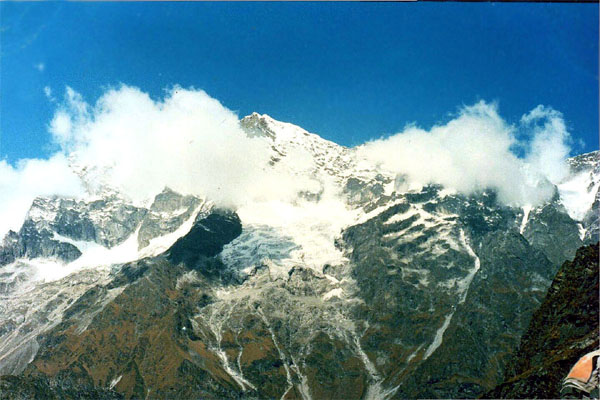 The Hemkund peak is our constant companion playing hide and seek with us. Finally it reveals in all its glory as we reach our destination after an arduous trek of four hours.
The Hemkund peak is our constant companion playing hide and seek with us. Finally it reveals in all its glory as we reach our destination after an arduous trek of four hours.
All through the trek one meets cooperative people.
The downstream pilgrims constantly encourage the upcoming ones and offer sweets and glucose. The gain in elevation elevates the soul too, no doubt!
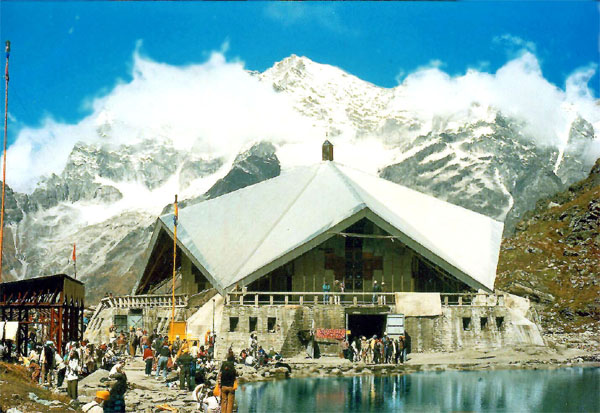
We have reached Hemkund. The place is unique for its mythological significance. Both the Ramayana and the Mahabharata are associated with this place. Hemkund/Lokpal was discovered by two devout Sikhs, Sant Solan Singh and Havaldar Mohan Singh by the details provided in Guru Gobind Singh’s autobiography. They chanced upon the place during a cartography mission. Though the place became a major pilgrimage centre only after 1930, its existence was known from ancient times. Streams from Hati Parvat and Sapt Rishi Peaks feed the lake. Hemkund suggests – Hem (snow) and Kund (lake). The altitude of this lake is 4329m. It is surrounded by seven huge snow-clad mountains collectively called Hemkund Parvat. This is a view of the Gurudwara. It is a grand star shaped structure of stone and masonry at the edge of the lake.
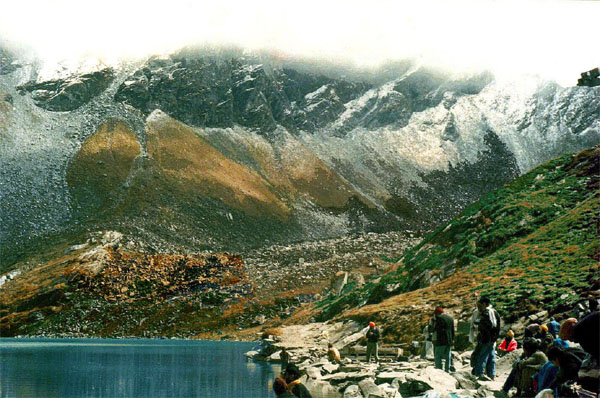
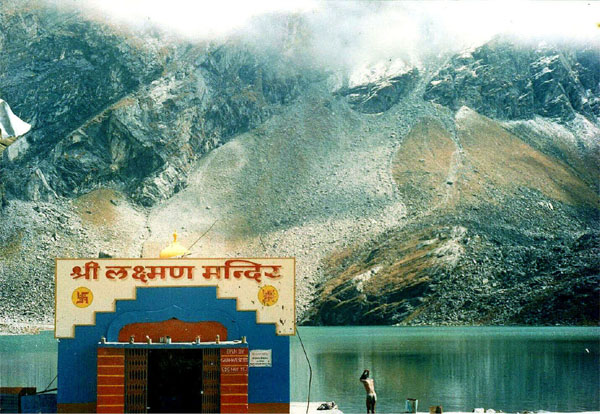
Standing with the Gurudwara behind us, the image on the left is the north view. Beyond those mountains over there is Tibet. At every mountain top are gun trotting Border Security Force men. The lake is the source of the Lakshmana Ganga (Hem Ganga) stream. It merges with the Pushpawati stream flowing from the Valley of Flowers, at Ghangharia. From that point on, the river is called Lakshmana Ganga.
The image on the right is the Lakshmana Temple or Lokpala Temple near the Gurudwara. It is the highest Hindu temple in the world. Pilgrims bath in the chilling water of the Lake chanting religious slogans. The legend goes that once Lakshmana, the younger brother of Ram, meditated by the lake and regained his health. Another legend has it that Rishi Medhasa of the Markandeya Purana, and King Pandu (the father of the five Pandavas), performed penance here during his Himalayan sojourn.
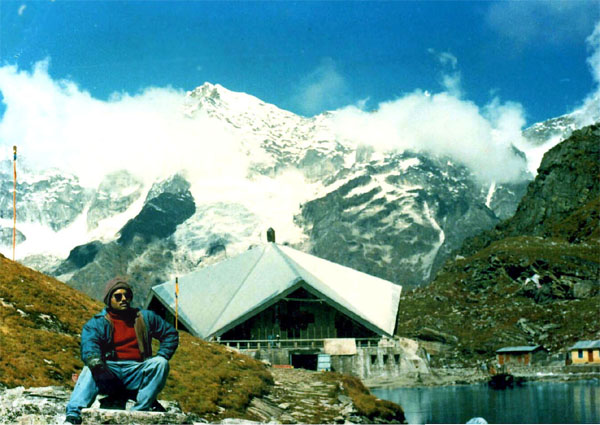
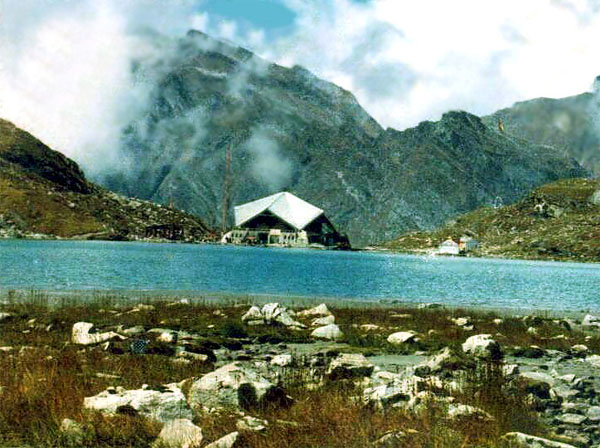
We now start a ‘Parikrama’ around the lake. Not many pilgrims do the Parikrama. Most pilgrims prefer to bath in the holy water and visit the Gurudwara and Lakshmana temple only. As we venture into our mission, we have an uncanny feeling of being watched by military personnel.
We stand just opposite to the Gurudwara on the other side of the lake. The Sikh legend has it that Guru Govind Singh, the Tenth Guru of the Sikhs and the founder of the Khalsa Panth, had meditated on the bank of this lake in one of his earlier births as Medhas Rishi. This is endorsed in the holy Granth Sahib.
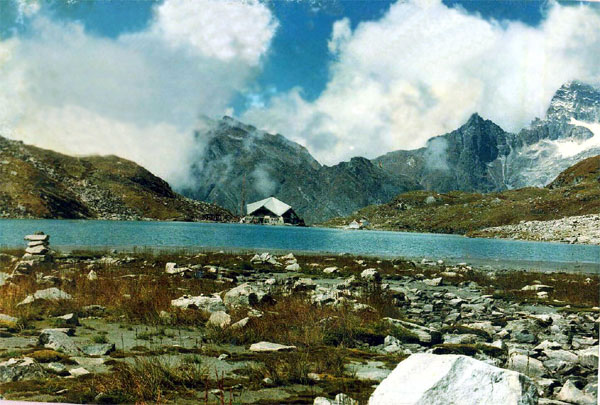 This religious spot is indeed a unique specimen of communal harmony.
This religious spot is indeed a unique specimen of communal harmony.
Another view of the Gurudwara and the Lakshmana temple. The credit of composition of this shot goes to my friend Arnab Mukherjee.
We complete our ‘Parikrama’ and it is now time to return.
We return with the rich experience of not only having visited the highest pilgrim place of the Hindu and Sikh community, but also with the experience that the ‘heart’ of humanity has always been in its proper place. A cynical civilization and culture down there in the plains can never corrupt the essential goodness of the ‘human heart.’ The only problem is, we tend to forget this truth down there in a chaotic society. A pilgrimage like this reminds us of the truth that is in us, of the truth that shall ever remain true!
02-Apr-2007
More by : Indrajit Bandyopadhyay

|
very nice place for walking |

|
Very excited.Good description.Hope this will guide us to reach the place. |